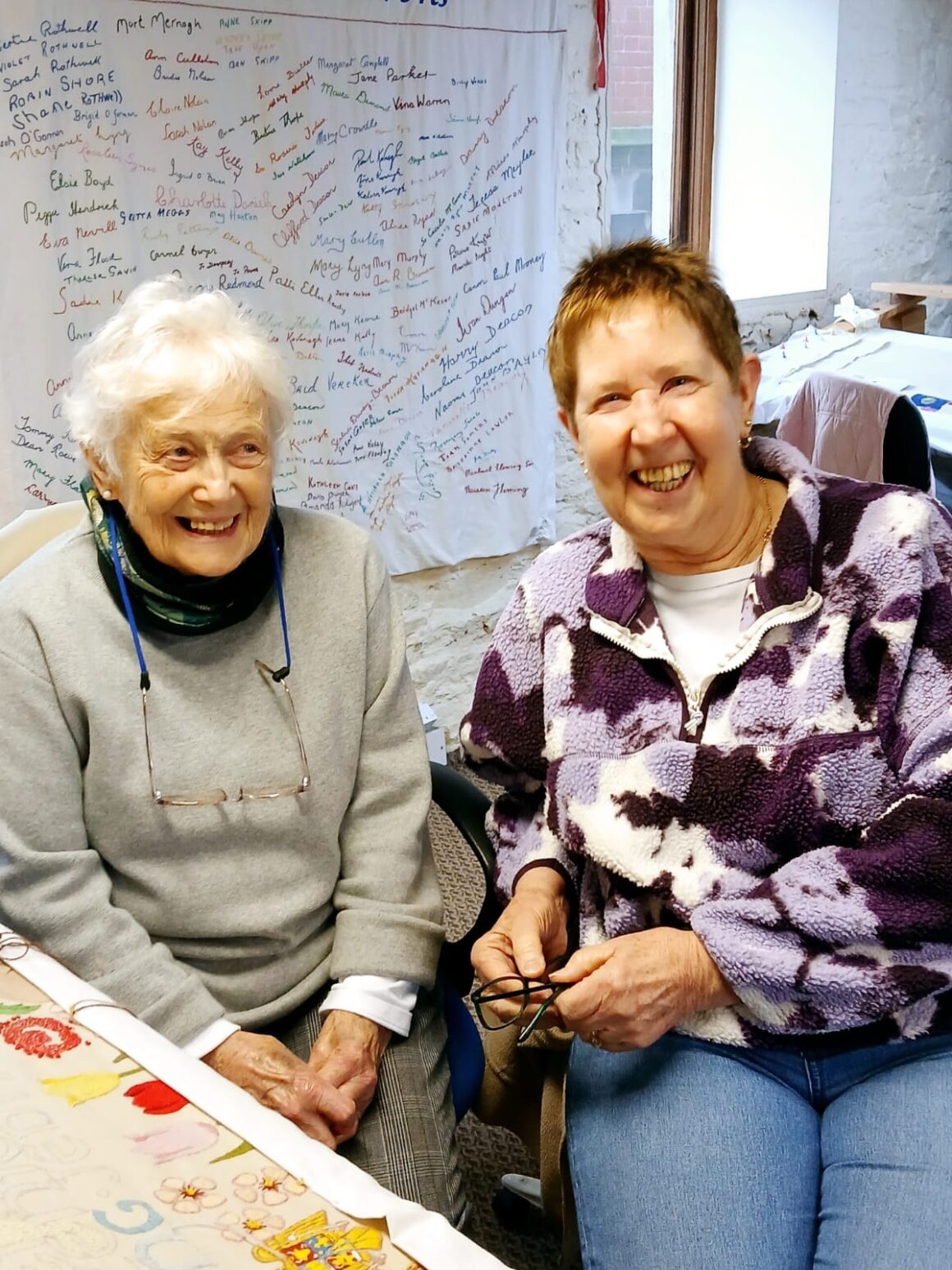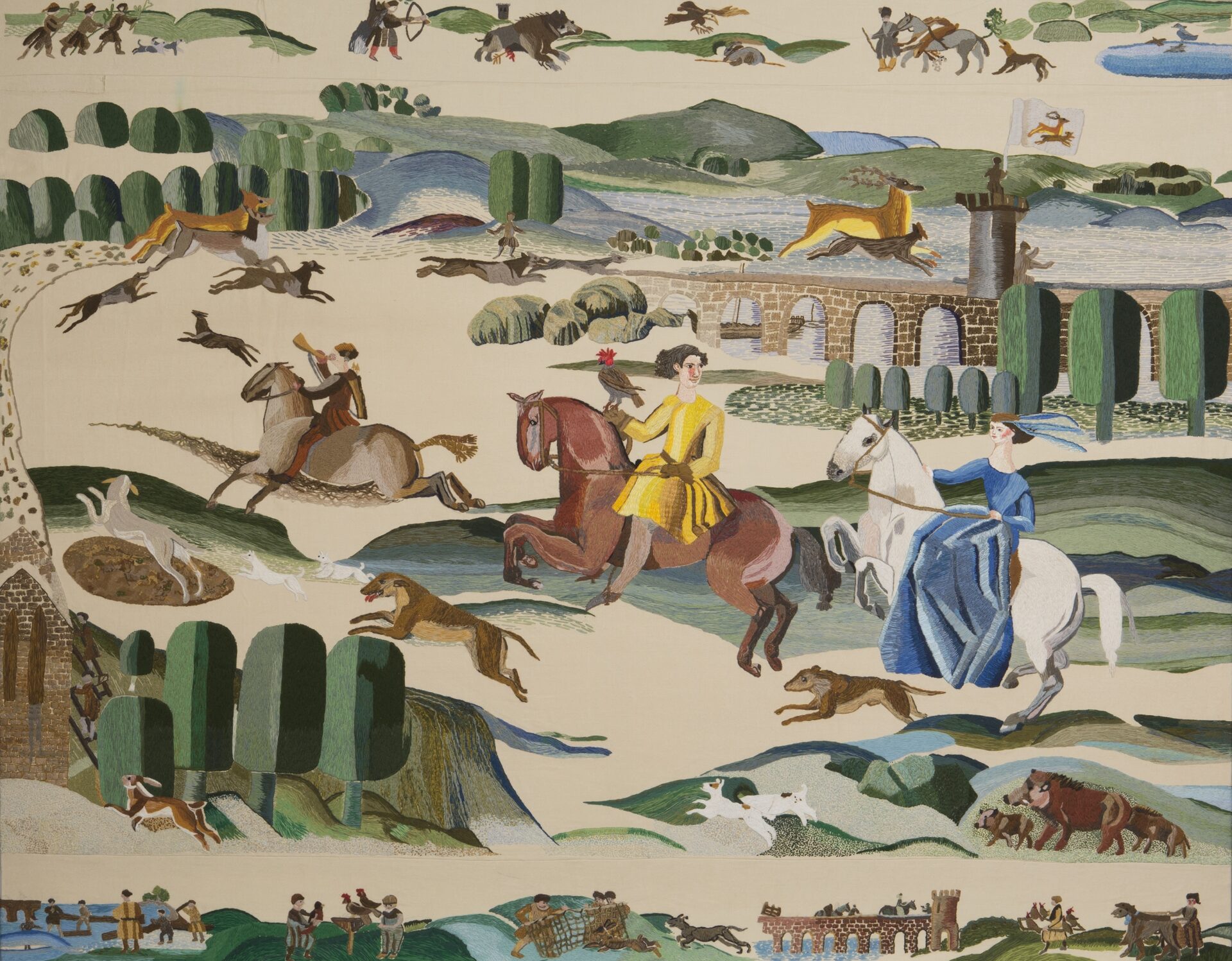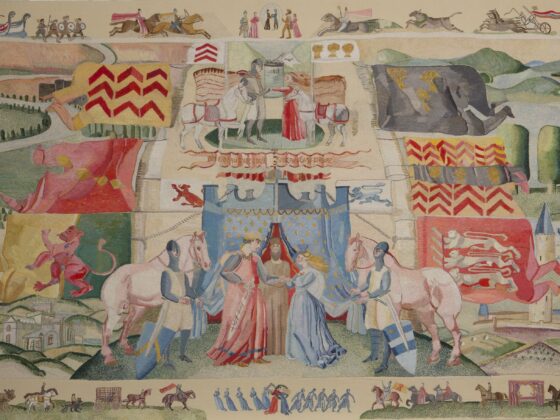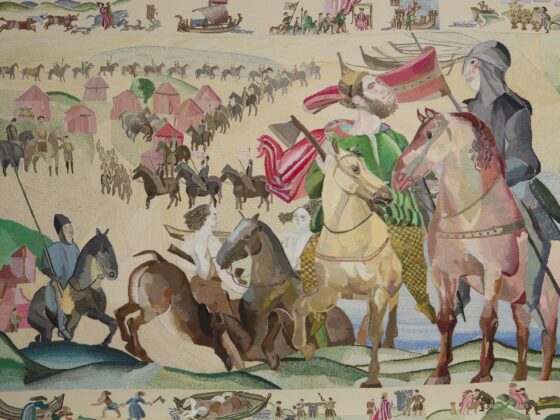THOMAS POOL INTERVIEWS STITCHER SUSAN SYNNOTT ABOUT THE ROS TAPESTRY – A MONUMENTAL PROJECT 27 YEARS IN THE MAKING CHRONICLING THE MEDIEVAL HISTORY OF NEW ROSS AND THE SOUTHEAST OF IRELAND.
Thomas Pool: What can you tell us about your background? What drew you to the Ros Tapestry project?
Susan Synnott: I have been interested in arts and crafts since my schooldays. I have been costume co-ordinator with New Ross Musical Society for about 20 years. I had an aunt who was a dressmaker, and I have been told that I have inherited her creativity! I suppose I grew up around this type of hobby. In college (where I studied Hotel Management) in the 1970s, I used to modify and make clothes for friends, including debs dresses and even wedding dresses. History, including the history of my town, has also been an interest of mine. My family have been in New Ross for generations and can be traced in the town back at least as far as the Battle of Ross in 1798.
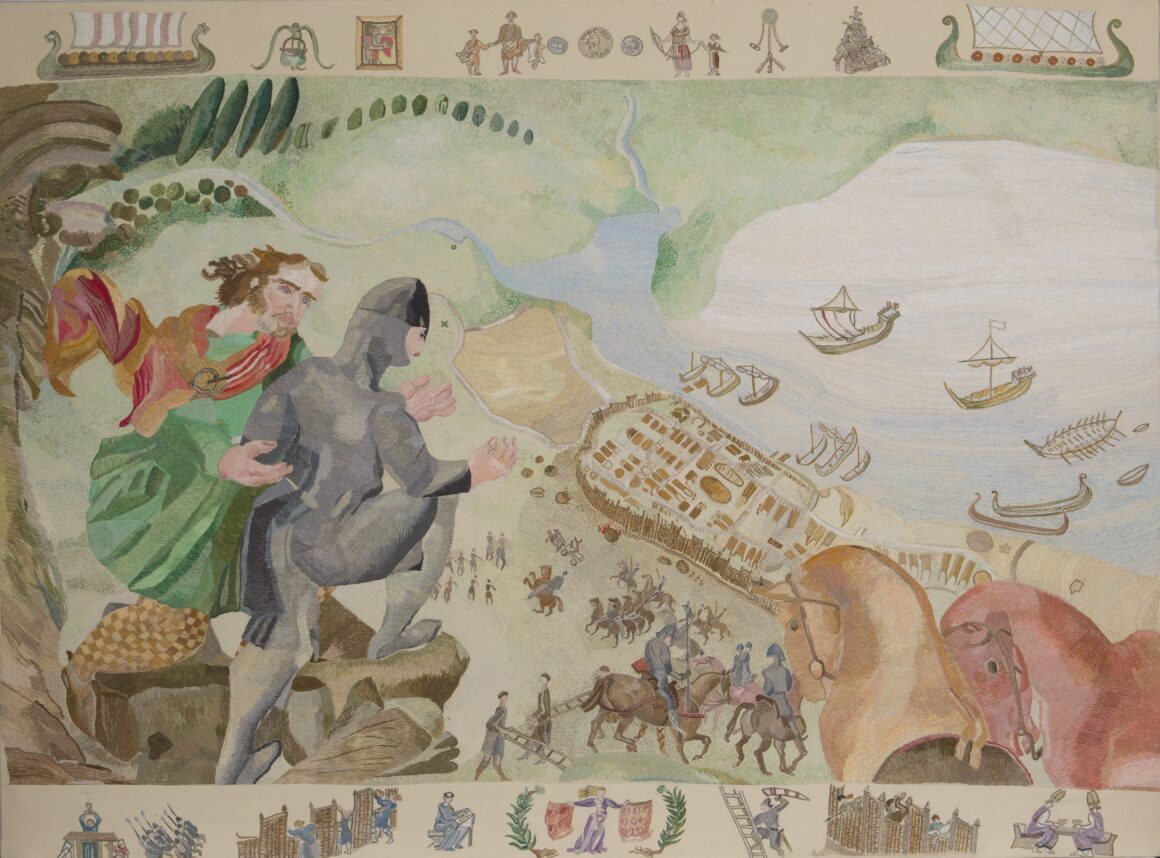
I can credit Rosa Ronan and her late husband John for my interest in the Ros Tapestry. I had heard about the project when it started but wasn’t in a position to become involved with it. I went to see an exhibition of some of the completed panels in the town park in 2007 during the 800th anniversary of the founding of New Ross by William Marshall and his wife Isabel. I was totally blown away by what I saw! I had no idea the panels were as big as they are – I thought they were just magnificent! I met Rosa and John there (I had known them for years before this) and they encouraged me to become a stitcher. It was a further two years, before I was in a position to become involved, but once I started in 2009, I never left it!
TP: Can you describe your specialist involvement in the Ros Tapestry project to date?
SS: I did a one-year embroidery course with Alexis Bernstorff, the then stitching co-ordinator of the project. Having served a probationary period of about six months, being taught the various crewel embroidery stitches by Alexis, I advanced to stitching on the main panels. As part of that course, I did a module in tour guiding with Ann Bernstorff, the creator of the cartoon images used in the making of the tapestries. I have always been interested in local history, so I loved doing the tours and telling the historical stories depicted in the panels. I worked part time as a tour guide with the tapestry during the summers of 2010 and 2011, when they were housed in Priory Court. At this time, the tapestry was staffed through the JFK Trust, where I worked as a chef in the Dunbrody Centre café.
In 2014, New Ross Needlecraft, who are guardians of the Ros Tapestry, were granted funding through Pobal for three full-time employees of their own. Pobal works on behalf of the government, and in conjunction with communities and local agencies, to support social inclusion and local and community development. I was one of the three appointed as a tour guide. I ended up doing accounts, marketing and basically anything needed to run the day-to-day business for the directors. I loved doing tours and found visitors were always delighted with the exhibition. As I was now employed by the company, I couldn’t stitch, as the stitchers are all volunteers. Unfortunately, the exhibition had to move to Kilkenny Castle during the Covid-19 pandemic and is about to reopen in New Ross. After the pandemic, I came back as a voluntary stitcher, and will continue there as long as I can.
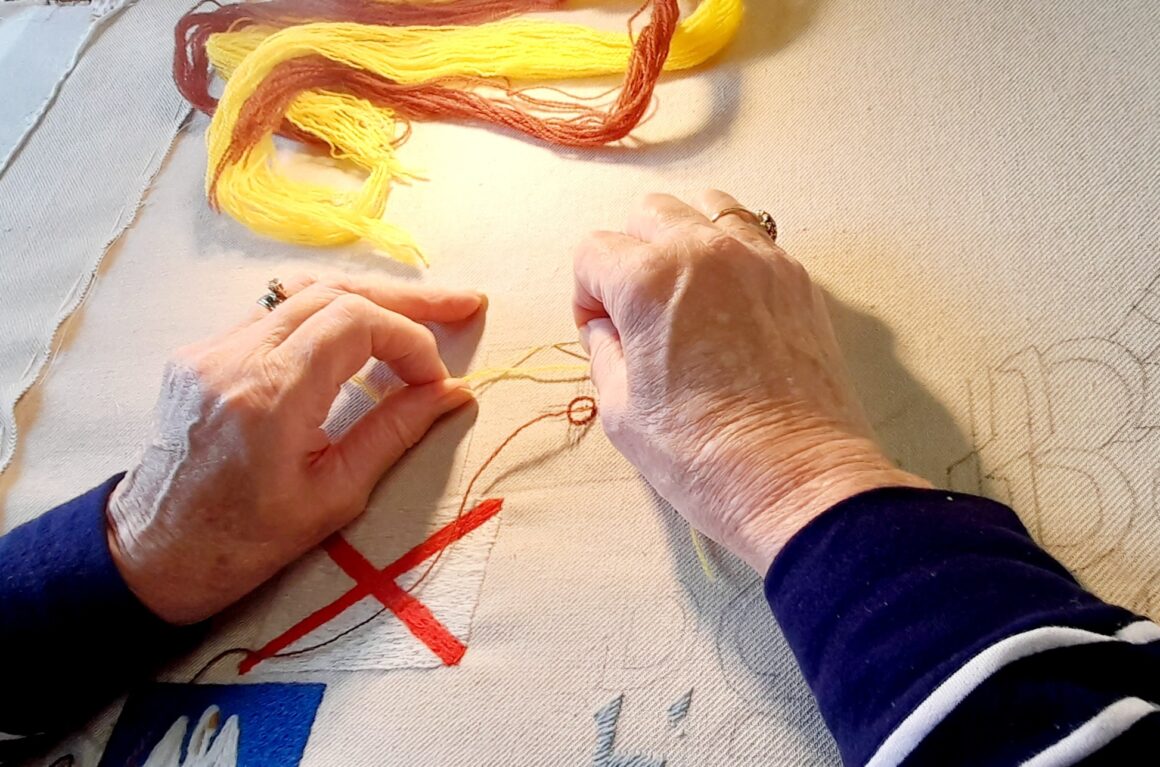
TP: The intricate and delicate needlework, required for such an ambitious project, is very labour intensive. How do you and your fellow stitchers tackle such a large-scale, durational project?
SS: As we are all volunteers, we work when we can. At the moment, it is only one morning a week. At times in the past, we stitched more often, but since the Ros Tapestry panels we worked on are all finished – apart from the Ossory panel, which is being done by our Kilkenny stitchers – we are not in as much of a hurry. We work at our own pace, and it takes as long as it takes. It is very time-consuming; you would only stitch about a square inch an hour, so everything takes time. We enjoy each other’s company and have many enjoyable chats as we stitch. It is a very relaxing pastime where you can forget your worries as you get lost in the intricacy of the work you’re doing. If it takes years to stitch a panel, well so be it. Perfection cannot be rushed!!
TP: Traditionally, needlework (including embroidery, knitting, and crochet) has not featured heavily in the art historical canon. How do you view the place of needlework in Irish cultural history?
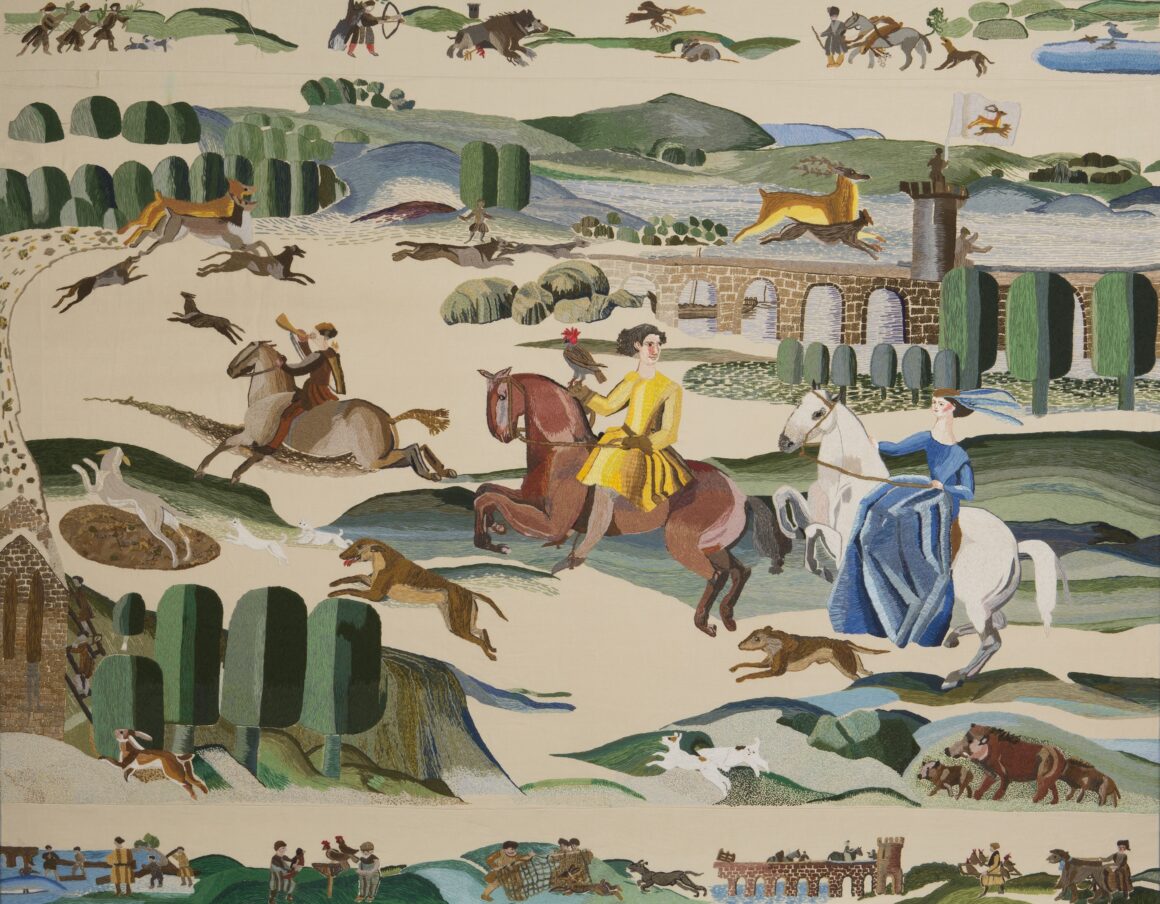
SS: All forms of art and craft have a place in some form or another in Irish cultural history. Art such as stained glass is well known in Irish culture – for example Harry Clarke’s world-renowned art is displayed in the National Museum. Needlecraft of many forms, such as knitting, embroidery, and lace-making, is a big part of our cultural history – from Aran knitwear and New Ross Lace, to Mountmellick Embroidery. Embroidery is possibly seen as a dying art, but it is an excellent way of telling a story. The Ros Tapestry tells in thread, the story of the arrival of the Normans in Ireland in the early-12th century and the influence they had on the future of the country. Embroidery has long been known as a way of telling historical stories, most famously in the Bayeux Tapestry in France.
TP: New Ross has recently seen renewed focus as the setting for Claire Keegan’s novel, Small Things Like These (Grove Press, 2021), and the film adaptation of the same name, starring Cillian Murphy. How do you view the Ros Tapestry within local and national history?
SS: The Ros Tapestry, if marketed properly, could add to the tourist value of New Ross. The history of the founding of New Ross and the subsequent Norman influence on many parts of Ireland starts in South Wexford where the Normans first landed. The history depicted in the Ros Tapestry is the early part of our history. It shows events in places such as Hook Lighthouse, Tintern Abbey, Saint Mary’s church in New Ross, as well as links with Waterford, Kilkenny Castle, and many other Norman sites. Visitors can view this history told in thread at our exhibition and then explore the many places they learned about in the panels. New Ross is already known as the homeland of the family of President John F. Kennedy, and the family homestead is a popular visitor attraction.
The Dunbrody famine ship is an example of the sad history of famine in Ireland from 1845 to1852. Claire Keegan’s novel is about our more recent past and the influence of the Catholic church on the Irish people. As you can see, local and national history can be experienced from Norman times right up to the present in our little town.
TP: The medieval inspiration for the tapestry is clear, with its style, design, and materials emulating artifacts like the Bayeux Tapestry. Do you feel that this medieval style limits the creativity of the stitchers? Or does it help to tell the story of New Ross and Wexford, where a more modern style may not?
SS: The style of embroidery as used in the Ros Tapestry is known as Crewel embroidery and in my estimation, it is a timeless style. It suits the style of the cartoons that we work from, which are medieval. The artist who drew our cartoons did tremendous historical research prior to painting them. She paints in what is known as naïve cartoon style, which gives it its medieval look. The telling of the story in embroidery is dependent on the cartoon on which the work is based.
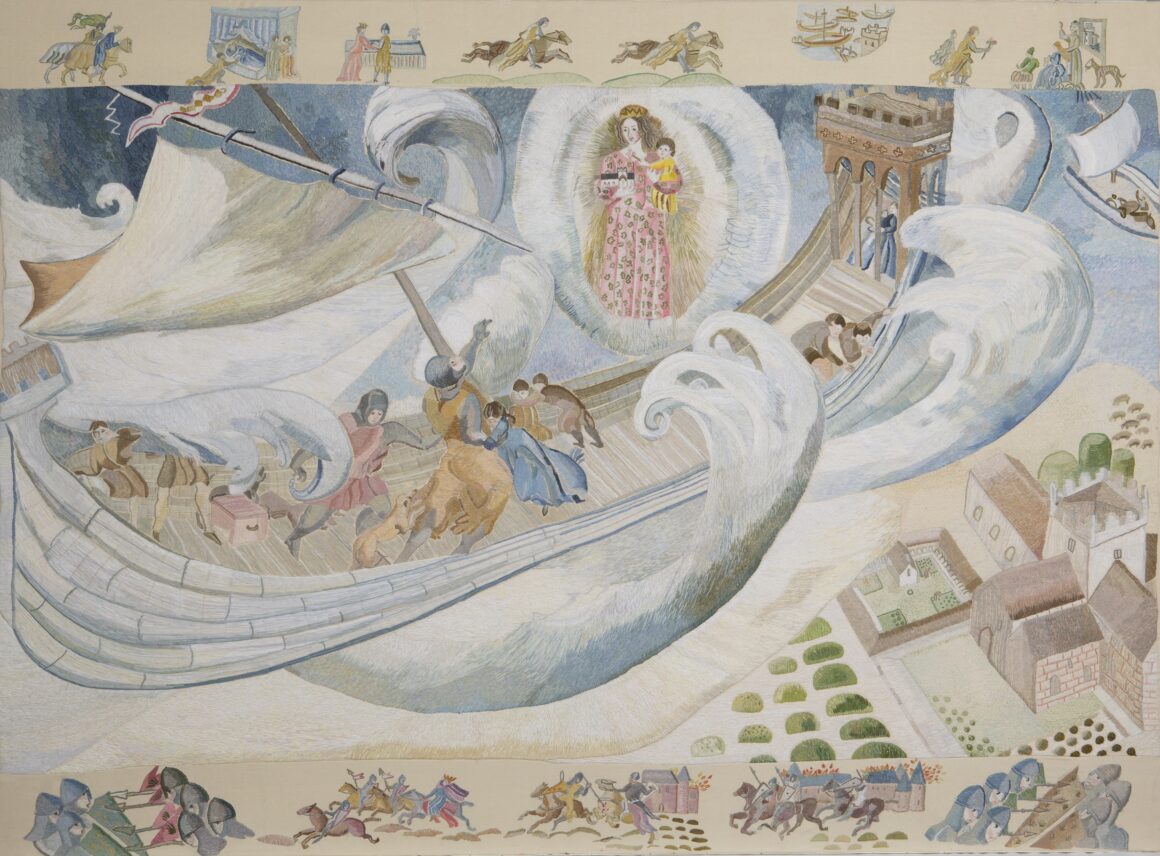
The creativity of the stitchers is evident in our current work, known as Threads of Friendship. This body of work is made up of two large panels about the same size as the Ros Tapestry panels. They are individually known as Unity – which broadly tells of the links between Ireland and the European Union – and Coming Home, which shows the connection between Ireland and America, linking it with the story of the Dunbrody Famine Ship. The same crewel stitches are used, along with the same wool and linen fabric, but the end product looks completely different and far more modern. Again, it is the cartoon on which the panels are based that dictates how the end product will look. The artist who did these cartoons, Reiltin Murphy, is a calligraphy expert, and this is also reflected in the style of her cartoons.
TP: Stitchers have been working constantly since the early 2000s to complete the Ros Tapestry. With 14 of the 15 panels of the tapestry now completed, what are the plans for the finished work?
SS: The finished work will be displayed in a new Norman museum, which is to be housed in an old bank building on the quay in New Ross. Here, they will form a central part of the museum. This project is jointly being undertaken by Wexford County Council, the JFK Trust (which operates the Dunbrody Famine Experience and the Kennedy Homestead) and New Ross Needlecraft, with Failte Ireland also involved. It is expected that this museum will be opened in 2027. The 14 completed panels have been displayed in Kilkenny Castle, under the care of the OPW, for the last three or four years. They have now returned to New Ross, where they will be temporarily on display until their permanent home is completed. As I said earlier, the stitchers are currently working on our ‘Threads of Friendship’ panels, now that our work on the Ros Tapestry panels is completed. We are also stitching small sections from the main panels to sell as souvenirs of the Ros Tapestry.
Susan Synnott is a volunteer stitcher for the Ros Tapestry project.
